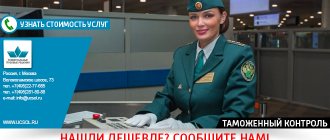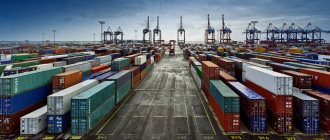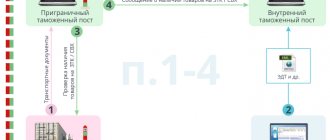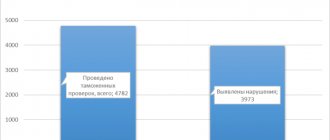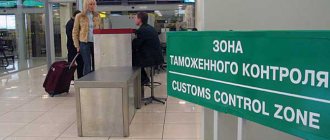Customs acts as the leading body exercising state control over the process of transporting products and transport across the state border. The procedure for performing such control is regulated by the TKTS (Customs Code of the Customs Union). Customs authorities carry out actions in accordance with legislation aimed at:
- currency control;
- fight against smuggling;
- state production politicians;
- control, supervision in the field of customs affairs.
All cases are very individual and depend on many factors. Basic information does not guarantee a solution to your specific problems. That's why FREE expert consultants work for you around the clock! via the form (below), and within an hour a specialized specialist will call you back to provide a free consultation.
Regulatory regulation in 2021
According to the provisions of Art. 112, questioning (oral) is limited by performing operations with transport, goods moved across the customs border. Individuals and persons acting as representatives of companies vested with authority regarding cargo and transport can be interviewed. The authorized representatives may be employees of the customs representative.
Obtaining explanations is considered one of the types of control carried out by customs. This is how the term is described in Art. 113 Labor Code of the Russian Federation. The procedure involves customs specialists obtaining the most important data from declarants transporting individuals. The decision of the CCC determined the written form with which explanations are drawn up. The decision came into effect on May 20, 2021. It was recorded under number No. 260 and called “On the forms of customs documents.”
Forms of customs control
All cases are very individual and depend on many factors. Basic information does not guarantee a solution to your specific problems. That's why FREE expert consultants work for you around the clock! right now through the form (below), and one of our lawyers will call you back to provide a free consultation.
with a production sharing agreement, when moving between the territory of the Russian Federation and the territories of artificial islands, installations, structures located outside the territory of the Russian Federation, over which the Russian Federation has exclusive jurisdiction, are not subject to placement under another customs procedure and are moved without paying customs duties , taxes and without the use of prohibitions and restrictions, while simultaneously meeting the following conditions:
1) the person who placed the goods under the customs procedure of release for domestic consumption using an exemption from payment of import customs duties and taxes in accordance with the production sharing agreement sent a notification of such movement to the customs authority that released the goods being moved in accordance with the customs release procedure for domestic consumption, as well as to the customs authority in whose area of activity operations for the movement of goods are carried out;
2) the movement of goods is carried out on aircraft and (or) sea vessels, which can repeatedly cross the State Border of the Russian Federation without passing border, customs and other types of control in the manner established by the legislation of the Russian Federation;
3) placement of goods under the customs procedure of release for domestic consumption using exemption from import customs duties and taxes under a production sharing agreement and operations for the movement of goods between the territory of the Russian Federation and the territories of artificial islands, installations, structures located outside the territory of the Russian Federation Federations over which the Russian Federation has exclusive jurisdiction are carried out in the area of activity of one regional customs department.
Article 210. Features of customs operations in relation to goods transported through the territories of states that are not members of the Union and (or) by sea, without being placed under the customs procedure of customs transit
The procedure for performing customs operations related to the departure from the customs territory of the Union of goods of the Union specified in subparagraph 3 of paragraph 5 and paragraph 6 of Article 302 of the Union Code, and the arrival on the customs territory of the Union of goods of the Union specified in subparagraph 4 of paragraph 5 of Article 302 of the Code of the Union, is determined the federal executive body exercising the functions of developing state policy and legal regulation in the field of customs affairs.
Article 211. Features of the application of the customs procedure of customs transit in relation to goods of the Union transported from one part of the customs territory of the Union to another part of the customs territory of the Union through the territories of states that are not members of the Union and (or) by sea
When placing under the customs procedure of customs transit on the territory of the Russian Federation goods of the Union transported from one part of the customs territory of the Union to another part of the customs territory of the Union through the territories of states that are not members of the Union, and (or) by sea, by rail in freight cars in the case, if the sender and the recipient are the same legal entity, as well as in postal, baggage (postal-baggage) cars traveling as part of passenger trains, customs operations related to the placement of these goods under the customs procedure of customs transit are carried out at the customs authority, in the region of activity in which goods are loaded (or the last consignment of goods in the case of simultaneous transportation of several consignments of goods).
Chapter 41. Introduction of a ban on the circulation of certain categories of goods in the Russian Federation
Article 212. Certain categories of goods on the circulation of which a ban may be introduced in the Russian Federation, and the procedure for applying this ban
1. The Government of the Russian Federation has the right to introduce a ban on the circulation in the Russian Federation of the following categories of goods:
1) goods in respect of which, when imported into the customs territory of the Union, customs duties are paid at rates different from the rates established by the Unified Customs Tariff of the Eurasian Economic Union, and (or) customs duty rates are applied that are different from the rates established by the Unified Customs Tariff of the Union ;
2) goods in respect of which, in accordance with the acts constituting the law of the Union, a member state of the Union has accepted an obligation to circulate and (or) locate or use such goods only on the territory of this state;
3) goods in respect of which a member state of the Union, including in cases determined by acts constituting the law of the Union, in trade with states that are not members of the Union, unilaterally applies tariff benefits, tariff preferences, tariff quotas and (or ) prohibitions and restrictions according to rules that differ from the general rules established by acts constituting the law of the Union and (or) rules applied in the Russian Federation;
4) goods in respect of which customs operations are carried out by persons who have been granted certain special simplifications, provided only on the territory of a member state of the Union that has concluded an international agreement with a state that is not a member of the Union on the provision of such simplifications, including on a reciprocal basis;
5) goods in respect of which, when imported into the Russian Federation from states that are not members of the Union, customs tariff regulation measures and (or) prohibitions and restrictions are applied only in the Russian Federation, including unilaterally, in the event if, when importing the specified goods into the customs territory of the Union, such customs tariff regulation measures and (or) prohibitions and restrictions are not observed.
2. The procedure for applying the ban on circulation in the Russian Federation of certain categories of goods provided for by this article, as well as the procedure for disposing of such goods if they are found in circulation in the Russian Federation, is determined by the Government of the Russian Federation simultaneously with the introduction of this ban.
3. When the Government of the Russian Federation introduces a ban on the circulation of certain categories of goods in the Russian Federation, the person specified in subparagraph 11 or 17 of paragraph 1 of Article 2 of the Code of the Union has the right to receive information about the release of goods in the member states of the Union in the manner prescribed by parts 5 — 16 Article 305 of this Federal Law. The absence of this information from the customs authority or the prohibition on its provision to other persons in accordance with international treaties of the Russian Federation is not a basis that exempts a person from complying with the ban on the circulation of certain categories of goods in the Russian Federation, established in accordance with this chapter.
Article 213. Federal executive authorities authorized to control and supervise compliance with the ban on circulation in the Russian Federation of certain categories of goods, as well as to dispose of such goods if they are found in circulation in the Russian Federation
Federal executive authorities authorized to control and supervise compliance with the ban on circulation in the Russian Federation of certain categories of goods provided for in Article 212 of this Federal Law, as well as to dispose of such goods if they are found in circulation in the Russian Federation, are determined by the Government of the Russian Federation at the same time with the introduction of this ban.
SECTION VI CUSTOMS CONTROL
Chapter 42. General provisions on customs control
Article 214. Conducting customs control
1. Customs control is carried out by customs authorities in accordance with the Code of the Union.
2. The procedure for carrying out customs control using forms of customs control and (or) measures ensuring the conduct of customs control, in the part not regulated by the Union Code, or in cases provided for by it, is determined by this Federal Law, and in the part not regulated by the Union Code and this Federal law or as provided for by this Federal Law - a federal executive body exercising the functions of developing state policy and legal regulation in the field of customs affairs.
21. The specifics of customs control in the Arctic zone of the Russian Federation, insofar as they are not regulated by the Union Code, are established by the Federal Law “On State Support of Entrepreneurial Activities in the Arctic Zone of the Russian Federation.” (Part introduced - Federal Law No. 194-FZ dated July 13, 2020)
3. Technologies (instructions) for applying forms of customs control and measures ensuring customs control, including in the form of administrative regulations, are established by the federal executive body exercising control and supervision functions in the field of customs affairs.
4. In order to verify information confirming the fact of release of goods, customs authorities may carry out customs control in relation to goods located on the territory of the Russian Federation, if the customs authorities have information that the goods were imported into the customs territory of the Union and (or) are located on the territory of the Russian Federation in violation of international treaties and acts in the field of customs regulation.
5. Forms of customs control and measures ensuring customs control may be used by customs authorities to ensure compliance with the ban on the circulation of certain categories of goods in the Russian Federation, introduced in accordance with Article 212 of this Federal Law, as well as to carry out other functions assigned to customs authorities in accordance with Article 254 of this Federal Law.
6. When carrying out customs control, customs authorities proceed from the principle of selectivity of objects of customs control, forms of customs control and (or) measures ensuring customs control.
7. When selecting objects of customs control, forms of customs control and (or) measures to ensure customs control, a risk management system is used.
8. For the purpose of carrying out customs control after the release of goods, as well as customs control in accordance with parts 4 and 5 of this article, customs authorities may select objects of customs control without developing and approving risk profiles.
9. Forms of acts, resolutions, instructions and other documents drawn up by customs authorities during and based on the results of certain forms of customs control and measures ensuring customs control, in accordance with the Code of the Union and this Federal Law, the procedure for filling out these forms and making changes in such documents, as well as the structure and format of such documents in the form of electronic documents, are established by the federal executive body exercising control and supervision functions in the field of customs affairs, except for cases where the specified powers are assigned to the Commission by the Union Code.
10. When carrying out customs control after the release of goods, as well as customs control in accordance with parts 4 and 5 of this article, the form of exchange of documents and (or) information with persons (on paper or electronic documents and (or) information in electronic form) is determined by the customs authority, taking into account the circumstances of application of the customs control form and (or) measures ensuring customs control.
Article 215. Time limits for customs control of the activities of persons included in the registers of persons carrying out activities in the field of customs affairs, or the register of authorized economic operators
Customs control of the activities of persons included in the registers of persons carrying out activities in the field of customs, or the register of authorized economic operators, may be carried out during the period of their presence in such registers, as well as until the expiration of two years after their exclusion from such registers.
Article 216. Features of customs control after the release of goods in relation to conditionally released goods
The federal executive body exercising the functions of developing state policy and legal regulation in the field of customs may establish the frequency and other requirements for customs control after the release of goods in relation to conditionally released goods specified in paragraph 1 of Article 126 of the Union Code.
Article 217. The procedure for creation, termination of operation (liquidation) and designation of customs control zones, requirements for them
1. Places that are customs control zones are determined in accordance with Article 319 of the Union Code and this article.
2. Customs control zones can be created along the State Border of the Russian Federation, at checkpoints across the State Border of the Russian Federation, at places of customs operations, at places of temporary storage of goods, unloading and transhipment (transshipment) of goods, their customs inspection and customs inspection, in parking areas for vehicles transporting goods under customs control.
3. Customs control zones may be permanent in the following cases:
1) if the owner of a land plot, water area, premises intends to use these territories exclusively for storing goods under customs control or performing other customs operations with such goods;
2) if in certain areas of the territory, water area, goods under customs control are primarily transported or stored, or other customs operations are carried out in relation to these goods, and restrictions on the movement of such goods across the borders of customs control zones or restriction of access to such goods is necessary to ensure compliance the laws of the Union and the legislation of the Russian Federation on customs regulation.
4. A temporary customs control zone is created by decision of the head of the customs post or a person authorized by him, and when carrying out customs control after the release of goods and in accordance with parts 4 and 5 of Article 214 of this Federal Law by decision of the head of the customs authority conducting customs control, or person authorized by him. The specified decision is formalized by order of the head of the customs authority or a person authorized by him, indicating the purpose of creating a temporary customs control zone, the location of the temporary customs control zone, the validity period, the border of the temporary customs control zone and the places of its crossing by persons, goods and vehicles, as well as the means of designation used.
5. The federal executive body exercising the functions of control and supervision in the field of customs, on the basis of a proposal from the customs authority whose region of activity includes the corresponding section of the territory of the Russian Federation, determines sections of the State border of the Russian Federation along which it is necessary to create customs control zones, and decides on the creation of such zones. The decision to create customs control zones along the State Border of the Russian Federation is formalized by a regulatory legal act of the federal executive body exercising control and supervision functions in the field of customs affairs, agreed upon with the federal executive body in the field of ensuring the security of the Russian Federation and the executive bodies of the constituent entities of the Russian Federation , in the territories of which the specified zones are created.
6. On the land portion of the territory of the Russian Federation, a customs control zone along the State Border of the Russian Federation can be created within a strip of terrain up to thirty kilometers wide from the line of the State Border of the Russian Federation deep into the territory of the Russian Federation. The decision to create a customs control zone within a strip of terrain up to thirty kilometers wide from the line of the State Border of the Russian Federation deep into the territory of the Russian Federation must indicate:
1) location of the checkpoint;
2) the border of the customs control zone and the place of its crossing by persons, goods and vehicles.
7. In sea, river and lake areas of the territory of the Russian Federation, a customs control zone along the State Border of the Russian Federation may be created, respectively, within the territorial sea of the Russian Federation, the Russian part of the waters of border rivers, lakes and other bodies of water, as well as a strip of terrain up to fifteen kilometers wide from coastline deep into the territory of the Russian Federation.
8. Customs control zones along the State Border of the Russian Federation are designated along its boundaries at points of intersection with transport routes, at places of crossing of the State Border of the Russian Federation by persons, goods and vehicles with signs containing the inscription “Customs Control Zone” in white on a green background, made in accordance with the technical specifications and standards defined for road information signs.
9. The decision to create a customs control zone at checkpoints across the State Border of the Russian Federation, established and opened in accordance with the legislation of the Russian Federation, is made by the head of the customs office in the region of operation of which the checkpoint is located. Such a decision is formalized by an order of the head of customs, agreed upon with the federal executive body exercising control and supervision functions in the field of customs affairs. The customs control zone created at the checkpoint across the State Border of the Russian Federation includes sections of the territory (water area), buildings, structures, sites within which customs operations, storage, unloading and transhipment (transshipment) of goods under customs control, their customs inspection and customs inspection, parking places for vehicles transporting such goods.
10. When determining the border of the customs control zone, the opinion of the administration of the transport infrastructure facility within which the checkpoint across the State Border of the Russian Federation is established must be taken into account: the head of the seaport administration, the head of the basin government authority for inland water transport, the operator of the airfield, the head of the railway station ( stations). The opinion of the administration of the transport infrastructure facility, drawn up in writing, is attached to the draft order of the head of customs on the creation of a customs control zone, sent for approval to the federal executive body exercising control and supervision functions in the field of customs affairs.
11. The order of the head of customs on the creation of a customs control zone at the checkpoint must indicate:
1) location of the checkpoint;
2) the border of the customs control zone and the place of its crossing by persons, goods and vehicles.
12. The annex to the order of the head of customs on the creation of a customs control zone at the checkpoint must contain a graphical representation of the border and territory of the specified zone in the form of plans or maps.
13. Decisions on the creation of customs control zones in other places are made by the head of the customs office in the region of whose activity the places and territories where customs control zones are created are located.
14. Decision on the creation of a customs control zone provided for in Part 1
The essence and types of procedures
The oral survey is represented as a separate form of control at customs. It is used in the case of clearance of goods and transport at customs. The essence of the procedure is for customs authorities to receive the required information from individuals authorized regarding transported goods and transport of citizens orally. Explanations do not require written documentation.
There is a limitation to oral questioning through customs clearance, which is determined by the movement of products and vehicles across the border.
Due to frequent changes in legislation, information sometimes becomes outdated faster than we can update it on the website. Submit your question using the form (below) and one of our lawyers will call you back to provide a free consultation.
Conducting an oral survey as a form of customs control in 2021
To carry out an oral survey of individuals transporting products, they are asked a number of questions when clearing products at customs.
Experts ask questions regarding products transported across the customs border of the state. Typically this data is relative to:
- presence/absence of products that are prohibited for movement across the border or subject to movement restrictions;
- volume of transported currency, etc.
Information provided in writing by individuals interviewed is not recorded.
Didn't find the answer to your question? Find out how to solve your specific problem. Write your question using the form (below), and our lawyer will call you back within 5 minutes with a free consultation.
Article 343. Customs escort.
TOPIC 3. CUSTOMS CONTROL MEASURES
1. List of customs control measures
2. Customs escort
3. Identification of goods
4. Customs surveillance
List of customs control measures
EAEU Customs Code Article 338. Measures to ensure customs control
1. When conducting customs control, depending on the objects of customs control, customs authorities have the right to apply the following measures to ensure customs control:
1) conduct an oral survey;
2) request, demand and receive documents and information necessary for customs control;
3) order a customs examination, take samples and specimens of goods;
4) identify goods, documents, vehicles, premises and other places;
5) use technical means of customs control, other technical means, watercraft and aircraft of customs authorities;
6) apply customs escort;
7) establish the route for transporting goods;
 keep records of goods under customs control and customs operations performed with them;
keep records of goods under customs control and customs operations performed with them;
9) attract specialists and experts from other government bodies of the Member States;
10) demand the performance of cargo and other operations in relation to goods and vehicles;
11) carry out customs surveillance;
12) check the availability of a goods accounting system and the maintenance of goods records;
Measures ensuring the implementation of customs control are applied independently or to ensure the application of forms of customs control.
Article 339. Oral questioning.
Customs officials have the right to conduct an oral survey of individuals, their representatives, as well as persons who are representatives of organizations, in order to obtain information relevant for customs control, without documenting the results of the survey.
Article 340. Request, demand and receipt by customs authorities of documents and (or) information necessary for carrying out customs control.
When carrying out customs control, customs authorities have the right to request and require from the declarant, the carrier to submit documents and information necessary for customs control, and also set a deadline for their submission.
The list of requested documents and information is determined by the customs authority based on the documents and information being checked, taking into account the terms of the transaction, the characteristics of the goods, and its purpose.
The deadline for the submission of such documents and information established by the customs authority in the request for the submission of documents and (or) information may be extended based on a reasoned request from the person. The period for which the submission of documents and information is extended is determined based on the person’s application, but should not exceed 2 months from the date of expiration of the deadline established by the customs authority for the submission of documents and information.
Customs authorities have the right to check the conformity of the submitted copies of documents with their originals.
If the submitted documents are drawn up in a language other than the official language of the Member State whose customs authority requested the documents, the persons who submitted them are obliged, at the request of an official of the customs authority, to provide translation of these documents.
Customs authorities have the right to request and receive from government bodies of the Member States, as well as from other organizations of the Member States, documents and information necessary for carrying out customs control, in accordance with the legislation of the Member States.
To carry out customs control, customs authorities have the right to receive, in accordance with the legislation of the Member States, from banks and non-bank credit (financial) organizations and organizations carrying out certain types of banking operations, documents and information on monetary transactions on transactions being carried out.
Customs escort
Article 342. Use of technical means of customs control, watercraft and aircraft of customs authorities.
When carrying out customs control, customs authorities may use technical means of customs control and technical means. Technical means of customs control must be safe for human life and health, animals and plants and must not cause harm to persons, goods and vehicles.
Customs control can be carried out using watercraft and aircraft of customs authorities.
Article 343. Customs escort.
Customs authorities use customs escort in order to ensure the transportation of goods under customs control across the customs territory of the Union.
Customs authorities have the right to use customs escort:
1) when transporting goods in accordance with the customs procedure of customs transit in the following cases:
— failure to provide security for the fulfillment of the obligation to pay import customs duties, taxes, special, anti-dumping, countervailing duties;
- repeated failure by the carrier to fulfill obligations when transporting goods in accordance with the customs procedure of customs transit, which was established by decisions on bringing into administrative liability that have entered into legal force, if at least one of these decisions is not executed;
— failure by the carrier to fulfill the obligation to pay import customs duties, taxes, special, anti-dumping, and countervailing duties within the prescribed period.
2) when transporting foreign goods under customs control, when, in accordance with this Code, such goods can be transported through the customs territory of the Union without being placed under the customs procedure of customs transit.
If the customs authority makes a decision to use customs escort, the customs authority informs the carrier about such a decision and organizes customs escort no later than 24 hours from the moment such a decision is made.
How do you receive clarifications?
When customs officers receive explanations, if they are carried out orally during the survey, they are not documented in writing. Customs officers require transporting persons and declarants to provide information that is considered important during customs control. They have the right to demand any data relating to customs affairs.
Employees usually provide explanations in writing. This is done in the form determined by the decision of the CCC. Its difference from an oral survey is considered to be the absence of restrictions by the customs institution. Explanations may be used where customs control is envisaged. This even applies to the production of products for domestic consumption.
Customs officers have the right to demand explanations from individuals connected with the transportation of products and vehicles across the customs border. These individuals are:
- forwarders;
- transporters;
- declarants.
Dear readers! Our articles talk about typical ways to resolve legal issues, but each case is unique. right now through the form (below), and our specialists will promptly prepare the best options for solving your problem and call you back on the day you submit your application. It's free!
Oral survey
FORMS OF CUSTOMS CONTROL Read more: Customs inspection of goods and vehicles
2. Oral survey.
Oral questioning, as a form of customs control, is also carried out during customs clearance of goods and vehicles moved across the customs border.
In comparison with the previous form of control, the possibility of conducting an oral interview is limited to customs clearance procedures caused by the movement of goods (vehicles) across the border.
Individuals are subject to questioning, as well as persons who are representatives of organizations that have authority in relation to goods (vehicles) being cleared, for example, a customs clearance specialist, in the case of customs declaration of goods by a customs broker.
This form of customs control is applied without written confirmation of the information received.
3. Receiving clarification.
Unlike an oral survey, the possibility of obtaining explanations is not limited by the institution of customs clearance and is allowed wherever the Labor Code of the Russian Federation provides for customs control, including after the release of goods for free circulation.
Moreover, customs authorities have the right to receive explanations from any persons who are related to the movement of goods and vehicles across the customs border (declarants, carriers, forwarders and other persons), and also have relevant information about the circumstances relevant for customs control .
Receipt of clarifications must be made in writing. The explanation form was approved by Order of the State Customs Committee of Russia dated November 24, 2003 No. 1323 “On approval of the document form.”
4. Customs surveillance.
Customs surveillance is public and targeted visual observation by customs officials of the transportation of goods and vehicles under customs control, and the performance of cargo and other operations with them.
Customs surveillance can be:
— systematically (for example, in the territory of a temporary storage warehouse) or one-time (when loading goods processed outside the location of customs authorities);
—direct or indirect (in the case of using special technical means of customs control).
Customs surveillance can be carried out:
— in the process of customs clearance of goods and vehicles (for example, in accordance with subparagraph 22.1 of Section III of the Instructions on customs operations during domestic and international customs transit of goods, cargo operations during VTT or MTT of goods are carried out with the permission of the customs authority with the implementation of customs control in the form as usually customs surveillance);
— in relation to goods and vehicles conditionally released on the customs territory of the Russian Federation (for example, stored in a customs warehouse or imported for processing purposes).
5. Customs inspection of goods and vehicles.
Customs inspection of goods and vehicles is also a visual examination, which is carried out by customs officials, but it is not the activity that is examined (as is the case with customs surveillance), but specific items.
The objects of inspection may be goods, luggage of individuals, vehicles, cargo containers, means of customs identification (for example, customs seals, stamps).
The peculiarity of the customs inspection of goods and vehicles is that it is always an external examination, which is not associated with opening the packaging of goods, the vehicle or its cargo space.
Customs inspection of goods and vehicles is carried out in the presence of the declarant and other persons with authority in relation to the items being inspected. Exceptions are made when this form of customs control is used when goods and vehicles are in the customs control zone (if the interested parties do not express a desire to be present during the customs inspection).
The mandatory written documentation of the results of customs inspection of goods and vehicles (in the form of an act drawn up in two copies) depends on one of the following factors:
—further use by customs authorities of inspection results, for example, as evidentiary information (Article 392 of the Labor Code of the Russian Federation);
—requirements of a person with authority in relation to the goods and (or) vehicles being inspected (as an alternative to the act, a note on the inspection may be noted in the transport document).
The form of the customs inspection report of goods and vehicles was approved by Order of the State Customs Committee of Russia dated October 20, 2003 No. 1166 “On the forms of customs inspection reports (inspection) of goods and vehicles.”
Customs inspection of goods and vehicles can be used as an independent form of customs control, for example, when completing internal customs transit, and as a derivative form of customs control when conducting a special customs audit (clause 4 of Article 376 of the Labor Code of the Russian Federation).
FORMS OF CUSTOMS CONTROL Read more: Customs inspection of goods and vehicles
Information about the work “Customs control”
Section: Customs system Number of characters with spaces: 81630 Number of tables: 0 Number of images: 0
Similar works
Problems of identification of customs control, customs clearance of timber imported from the Russian Federation
118809
0
0
... simplify and speed up customs control. All this will be considered in relation to goods and vehicles that have already arrived at the specified place of delivery, are placed in the customs control zone and their customs clearance is expected to be completed by release for domestic consumption. Those. concepts and definitions will be presented in general terms, and all other subtleties and details...
Forms of customs control in the Russian Federation
94618
0
2
... and making a decision based on the results of the customs audit. 3. Analysis of the regulatory legal framework of the Federal Customs Service of the Russian Federation, adopted in pursuance of the provisions of the new Customs Code of the Russian Federation, regarding the application of customs control forms. Further improvement of the customs clearance and customs control system, gradual preparation for work on ...
Forms and procedure for customs control
40004
0
0
... from persons providing guarantees for the proper fulfillment of duties established by this Code, including in the form of security for the payment of customs duties. 2. Forms and procedure for customs control. When carrying out customs control, customs authorities proceed from the principle of selectivity and, as a rule, are limited only to those forms of customs control...
Documentary control as a form of customs control
40093
0
0
... customs authorities carrying out customs clearance and customs control when declaring and releasing goods, verification of documents and information is indicated by documentary control. Verification of documents and information is a form of customs control used by a customs official when carrying out customs clearance of goods for the purposes of: checking the correctness of documents; ...
Protection of rights and consequences in 2021
Persons who are interviewed verbally at customs bear responsibility according to the laws of the country. Customs authorities may also be punished for violations. If you believe that your rights have been violated, you have the right to apply to arbitration or court.
Thanks to the high-quality implementation of the forms used by customs to monitor compliance with the requirements of customs legislation, threats to state security are countered, problems of a socio-economic nature are solved, and ideal conditions for the functioning of trading communities, legal entities, and individuals are created.
Forms of customs control are described in the video below:
Measures to ensure customs control and their application
Article 338. Measures to ensure customs control
1. When conducting customs control, depending on the objects of customs control, customs authorities have the right, in accordance with this Code, to apply the following measures to ensure customs control:
1) conduct an oral survey;
2) request, demand and receive documents and (or) information necessary for customs control;
3) order a customs examination, take samples and (or) samples of goods;
4) identify goods, documents, vehicles, premises and other places;
5) use technical means of customs control, other technical means, watercraft and aircraft of customs authorities;
6) apply customs escort;
7) establish the route for transporting goods;
 keep records of goods under customs control and customs operations performed with them;
keep records of goods under customs control and customs operations performed with them;
9) involve a specialist;
10) attract specialists and experts from other government bodies of the Member States;
11) demand the performance of cargo and other operations in relation to goods and vehicles;
12) carry out customs surveillance;
13) check the availability of a goods accounting system and the maintenance of goods records;
14) other measures to ensure customs control, established by the legislation of the Member States on customs regulation.
2. Measures ensuring the implementation of customs control are applied independently or to ensure the application of forms of customs control.
3. Measures to ensure customs control are applied in accordance with this chapter, and the purpose of customs examination is in accordance with Chapter 53 of this Code.
Article 339. Oral questioning
Customs officials have the right to conduct an oral survey of individuals, their representatives, as well as persons who are representatives of organizations, in order to obtain information relevant for customs control, without documenting the results of the survey.
Article 340. Request, demand and receipt by customs authorities of documents and (or) information necessary for customs control
1. When carrying out customs control, customs authorities have the right to request, and in cases established by this Code, demand from the declarant, carrier, persons carrying out activities in the field of customs affairs, and other persons to submit documents and (or) information necessary for carrying out customs control control, as well as establish a deadline for their submission, which should be sufficient to provide the requested (demanded) documents and (or) information.
2. The list of requested (demanded) documents and (or) information is determined by the customs authority based on the documents and (or) information being checked, taking into account the terms of the transaction, the characteristics of the goods, its purpose, as well as other circumstances.
3. The deadline for the submission of such documents and (or) information established by the customs authority in the request (demand) for the submission of documents and (or) information may be extended on the basis of a reasoned appeal from the person to whom the request (demand) was sent, including for the restoration of lost documents . The period for which the submission of documents and (or) information is extended is determined based on the application of the person to whom the request is sent, but should not exceed 2 months from the date of expiration of the deadline established by the customs authority for the submission of documents and (or) information.
4. When conducting customs control in the form of checking customs, other documents and (or) information, the customs authority requests documents and (or) information in accordance with Article 325 of this Code, with the exception of the cases provided for in Article 326 of this Code, when documents and (or) information is requested in accordance with this article.
5. Documents requested by customs authorities are presented in the form of originals or their copies, including paper copies of electronic documents, unless international treaties and acts in the field of customs regulation establish the mandatory submission of original documents.
Submitted copies of documents must be certified by the person who submitted them.
Customs authorities have the right to check the conformity of the submitted copies of documents with their originals.
If the submitted documents are drawn up in a language other than the official language of the Member State whose customs authority requested the documents, the persons who submitted them are obliged, at the request of an official of the customs authority, to provide translation of these documents.
6. The declarant, carrier, persons carrying out activities in the field of customs, and other persons are obliged to submit to the customs authorities documents and (or) information necessary for customs control, in oral, written and (or) electronic forms.
7. Customs authorities have the right to request and receive from government bodies of the Member States, as well as from other organizations of the Member States, documents and (or) information necessary for carrying out customs control, in accordance with the legislation of the Member States.
8. To carry out customs control, customs authorities have the right to receive, in accordance with the legislation of the Member States, from banks and non-bank credit (financial) organizations and organizations carrying out certain types of banking operations, documents and (or) information about monetary transactions on ongoing transactions.

